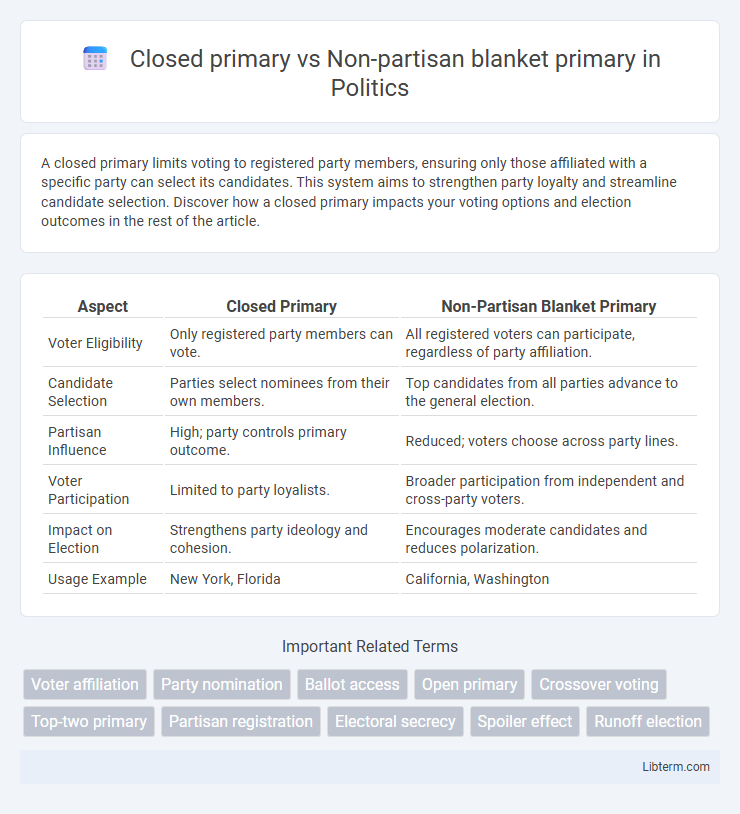A closed primary limits voting to registered party members, ensuring only those affiliated with a specific party can select its candidates. This system aims to strengthen party loyalty and streamline candidate selection. Discover how a closed primary impacts your voting options and election outcomes in the rest of the article.
Table of Comparison
| Aspect | Closed Primary | Non-Partisan Blanket Primary |
|---|---|---|
| Voter Eligibility | Only registered party members can vote. | All registered voters can participate, regardless of party affiliation. |
| Candidate Selection | Parties select nominees from their own members. | Top candidates from all parties advance to the general election. |
| Partisan Influence | High; party controls primary outcome. | Reduced; voters choose across party lines. |
| Voter Participation | Limited to party loyalists. | Broader participation from independent and cross-party voters. |
| Impact on Election | Strengthens party ideology and cohesion. | Encourages moderate candidates and reduces polarization. |
| Usage Example | New York, Florida | California, Washington |
Introduction to Primary Election Systems
Closed primaries restrict voting to registered party members, reinforcing party control over candidate selection by limiting participation to those affiliated with the party. Non-partisan blanket primaries, often called "top-two" primaries, allow all voters to choose among all candidates regardless of party affiliation, with the top two vote-getters advancing to the general election, promoting broader voter engagement. These differing primary election systems significantly impact candidate diversity, voter turnout, and party influence in the electoral process.
Defining Closed Primaries
Closed primaries restrict voting to registered party members, ensuring that only Democrats vote in Democratic primaries and only Republicans in Republican primaries, which strengthens party control over candidate selection. In contrast, non-partisan blanket primaries allow all voters to participate regardless of party affiliation, with the top candidates advancing to the general election regardless of party. This distinction affects voter participation patterns and the ideological composition of candidates moving forward.
Understanding Non-partisan Blanket Primaries
Non-partisan blanket primaries allow all candidates, regardless of party affiliation, to compete on the same ballot, enabling voters to select any candidate without party restrictions. This system promotes a broader spectrum of choices and often leads to the top two vote-getters advancing to the general election, regardless of party. Unlike closed primaries, which limit participation to registered party members, non-partisan blanket primaries encourage cross-party voting and can reduce partisan polarization.
Key Differences Between Closed and Non-partisan Blanket Primaries
Closed primaries restrict voting to registered party members, ensuring only those affiliated with the party can select its candidates, while non-partisan blanket primaries allow all voters, regardless of party affiliation, to vote for any candidate. In closed primaries, candidates compete within their parties, promoting partisan alignment, whereas non-partisan blanket primaries feature all candidates on one ballot with the top vote-getters advancing, often leading to crossover voting. The key difference lies in voter eligibility and candidate selection process, impacting party control and voter influence in candidate nomination.
Voter Eligibility and Participation
Closed primaries restrict voter eligibility to registered party members, limiting participation to those affiliated with the party holding the primary. Non-partisan blanket primaries allow all registered voters to participate regardless of party affiliation, increasing voter participation and encouraging broader candidate evaluation. This open participation model enhances electoral competition by enabling voters to select candidates across party lines.
Impact on Political Parties
Closed primaries restrict voting to registered party members, reinforcing party control over candidate selection and promoting ideological consistency within the party. Non-partisan blanket primaries allow all voters to participate regardless of party affiliation, weakening traditional party influence and encouraging candidates to appeal to a broader electorate. This system often results in more moderate candidates but can dilute party platforms and reduce the power of party organizations.
Influence on Candidate Selection
Closed primaries limit candidate selection influence to registered party members, ensuring nominees align closely with party ideologies and reducing outsider impact. Non-partisan blanket primaries allow all voters to participate regardless of party affiliation, promoting broader candidate appeal but potentially diluting party-specific preferences. This system can lead to the election of candidates with more moderate or cross-party support, altering traditional nomination dynamics.
Effects on Electoral Outcomes
Closed primaries limit voting to registered party members, often reinforcing partisan loyalty and reducing crossover voting, which can lead to the nomination of candidates more aligned with the party base. Non-partisan blanket primaries allow all voters to participate regardless of party affiliation, increasing competition and the likelihood of moderate candidates advancing to general elections. This system can produce more centrist electoral outcomes by encouraging candidates to appeal to a broader electorate beyond party extremes.
Pros and Cons of Each Primary System
Closed primaries limit voting to registered party members, enhancing party loyalty and candidate alignment but reducing voter participation and diversity. Non-partisan blanket primaries allow all voters to choose any candidate regardless of party, increasing voter inclusion and moderating extremes but potentially diluting party influence and complicating candidate selection. Each system balances party control against voter accessibility, impacting electoral dynamics and candidate viability.
Implications for Democratic Representation
Closed primaries restrict voting to registered party members, which can limit candidate choices and reduce cross-party voter influence, potentially reinforcing partisan divisions. Non-partisan blanket primaries allow all voters to participate regardless of party affiliation, often resulting in more moderate candidates who appeal to a broader electorate and enhancing overall democratic representation. The broader voter inclusion in blanket primaries can increase candidate accountability and better reflect diverse voter preferences compared to closed primaries.
Closed primary Infographic

 libterm.com
libterm.com